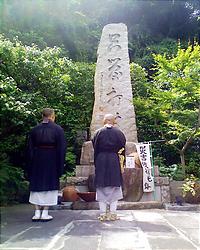« 鮮やかな実たち | 最新記事 | 12/22 廃油を持って いざ鎌倉へ! »
2008年12月13日
道元禅師鎌倉御行化顕彰碑

鎌倉・鶴岡八幡宮に隣接する場所に、高祖道元禅師鎌倉御行化顕彰碑があります。

道元禅師鎌倉御行化顕彰碑(災害たすけあい托鉢・鎌倉編の際に撮影)
建長寺を通り鎌倉中心地へと結ぶ県道21号線沿いにありますので、前を通過された方は多いと思いますが、その場所に立ち寄られた方は少ないのではないでしょうか。
曹洞宗の高祖・道元禅師は、宝治元年(1247)に越前より鎌倉の地に下向されます。
そして、鎌倉・白衣舎において宝治2年(1248)3月までの半年間を過ごされます。
宝治二年〈戊申〉三月十四日の上堂に、云く。山僧、昨年八月初三日、山を出て相州の鎌倉郡に赴き、檀那俗弟子の為に説法す。 今年今月昨日、帰寺、今朝陞座す。『永平広録』巻3?251上堂つらつら日暮らしWikiより一部引用
白衣舎がどこにあったのか、今でも不明です。
その場所を明らかにするべく神奈川県において研究が行われてきました。
経緯
昭和27年、高祖道元禅師七百回大遠忌を機に大本山永平寺七十三世熊澤泰禅禅師により発願。
その意思を受け継ぎ、地元鎌倉市龍宝寺住職団野老師を中心に道元禅師鎌倉下向の研究が進みました。
その後、高祖道元禅師七百五十回大遠忌局会議にて道元禅師鎌倉御行化の顕彰を行うことが決まり、数回の研究シンポジウムが開催されました。
数回の研究会、シンポジウムを経て、白衣舎の所在地を特定するためではなく、道元禅師が鎌倉御行化の事蹟を顕彰するために、鎌倉の適地を選定し、顕彰碑を建立することとなり、鶴岡八幡宮に隣接する現地が選ばれました。
平成13年11月に地鎮式が行われ、平成14年3月にはついに高祖道元禅師鎌倉御行化顕彰碑落慶除幕式および記念講演会が厳修行されました。
碑文には、顕彰碑建立への趣意が刻まれています。
曹洞宗高祖 永平道元禅師七百五十回大遠忌に値り、我等遠孫今茲に心を一にして、禅師鎌倉行化の事蹟を些か詳らかにし、その恩澤に報いんとする。
高祖越前入山後五年目の宝治元年(一二四七)八月三日、時に禅師四十八歳、永平寺開基大檀那波多野義重公(越前志比庄の地頭、京都六波羅探題評定衆)より鎌倉下向の懇請黙し難く、公の先君鎌倉幕府三代将軍源実朝公供養の為同年十一月十五日奉修せる鶴岡八幡宮放生会の彿縁を期してか、永平寺叢林を初めて離れ、漸くのこととして鎌倉行化の途に着く。
禅師がその師天童如浄禅師の遺誡を固く守り、権門に近づくことを極力厭い能くよく留意し、「只管打坐」の法燈を行持されたことを拝するとき、この行化は必ずしも心に添うものではなかったと推察される。然し、翌宝治二年三月十三日、永平寺帰山までの凡そ半年余、その波多野公の邸を始め名越白衣舎等鎌倉近在の諸処に在って、執権北条時頼公並びに妻室など、道俗諸緑の求めに応じ、説法授戒等の化導を為し正伝の彿法を弘められたと伝えられる。
以後一生不離叢林の志を益々強め、世寿五十四歳を以て遷化されるまで、永平寺に在って門弟等を教化示誨された行實等に触れるとき、感慨深いものを覚えるのは、我等法孫のみであろうか。
尚、時下って室町時代五山僧の記したものの中に、執政に日々懊悩する時頼公に対して、禅師が大政奉還出家入道を淡々と提言されたと見い出されることは、禅師の彿法中心第一の立場を物語って余りあろう。
終りに、禅師鎌倉滞在中に詠じられたと伝わる和歌を刻し、報恩の丹心を表す。
大本山永平寺監院 南澤道人 撰
維時 平成十四壬午平年三月吉辰謹拝建之
"About Dogen And His Mission To Kamakura"The Great Abbot, Zen Master Dogen was born in 1200. Long before his teens he was, initially due to his mother's death, awakened to uncertain and transitory nature of life in mortality and consequently entered the monkhood at the age of 13. Gradually he came to have a firm aim of more guesting for not only his own self-being but also all the self-beings themselves in the mutable cosmos. At the age of 24 he managed to go to China, which was in those days a centre of formal Zen training, and devoted himself entirely to true Zen practice luckily under strict yet courteous guidance of The Righteous Abbot, Zen Master Nyojo at Mt. Tendo's Zen monastery.
No sooner had he experienced "dropping off both body and mind (SHINJIN-DATZURAKU)" one night during the sitting session at the meditation hall than he was thrown into the spheres of enlightenment, grasping the true way of the Buddha's teachings.
Back home to Japan in 1228, he first stayed at Ken-ninji temple for some three years and then founded his first independent Zen temple, Kosho-horinji, in Uji, close to Kyoto and formed a small pursuing group of followers for the first time.
In 1243 Dogen was driven, for some reason or other, to moved to Shii-no-sho in Echizen Province (now Fukui Pref.), followed by a somewhat bigger group of his deciples and followers for the purpose of establishing some mountain retreat monasteries. Kindheartedly offered land and lots of helps for this mission by Yoshishige-Hatano, a samurai who was one of his most devoted lay followers, Dogen thus founded Eiheiji, which later became one of the two head monasteries of Soto Zen School in Japan, where he devoted himself thoroughly to training his deciples in the perfection of Zen practice in every action of daily life.
That is; he was to transmit the true Buddhist Dharma teachings to Japan and he himself, therefore, is regarded as the very first forerunner of Soto Zen School in Japan.
He died on Sep. 29. 1253, leaving behind a number of noted volumes on Buddhist teachings including SHOBOGENZO "The Treasury of the Eyes to see truly the Cosmic Laws", FUKANZAZENGI "The General Promotion of the Principles of Zazen", EIHEIKOROKU "The General Observations upon the True Laws by Zen Master Dogen".
The Zen Master Dogen's authentic Zen has been scrupulously observed by his successors. Even today, all pursuers, from priests and monks down to lay followers, devote themselves to his practice of "SHIKANTAZA 只管打坐 (just sitting only in its profound sense)",Which was advocated by him not as a means for enlightenment but as enlightenment itself.
This is a short sketch of his lifetime deeds. During his serene yet zealous monastic life at Eiheiji, only once and away, Dogen was interrupted by a visit to Kamakura. The reasons and purposes of that journey are not clear and untraceable by now, and seem to have vanished far into the mist of the history, becoming almost enigma to us,- he himself was necessitated to visit, together with a few deciples and other followers, to Kamakura, centre of secular authority then.
And there he seems, by our limited inference, to have spent most of his time, a little more than half a year (1247-1248), in Kamakura and its vicinities, in making a fervent and earnest attempt to transmit the Buddha Shakyamuni's true teachings to those who asked for them.
He conducted this mission; in fact, he did it simply in a sincere and serene state of mind, probably strange to those who hear this, though.
Because it seems that it was not an utterly willing thing to do for him to go down to Kamakura, only not to nestle up to secular authorities even though for the name of his Eiheiji monastery's benefits.
Finally we would be so honoured and privileged to present you this rather well-known waka, Japanese traditional 31-syllable poem, one of those which were supposedly composed by Dogen while here in Kamakura and handed down to us, in our hands such as a precious parting gift, which reads as follows;In conclusion;
In spring - the blossoms,
in summer - the cuckoo,
in autumn - the moon,
in winter - the snow;All is in the pure and clear,
that'sit!
鎌倉にお越しの際は、是非この顕彰碑をお参りください。
中央の「只管打坐」の文字は、百八歳の禅師様として知られる大本山永平寺七十八世宮崎奕保禅師による揮毫です。
また、顕彰碑の周囲には道元禅師の詠歌十二首が刻まれています。
今年は、12月22日に歳末たすけあい托鉢で鎌倉市を中心に廻る予定です。
そして、その日の夕方より、この高祖道元禅師鎌倉御行化顕彰碑においてキャンドルナイトが行われます。
以下、次の記事に続く
■関連ブログ記事
道元禅師降誕の日と鎌倉歴史散歩
災害たすけあい托鉢・鎌倉編

